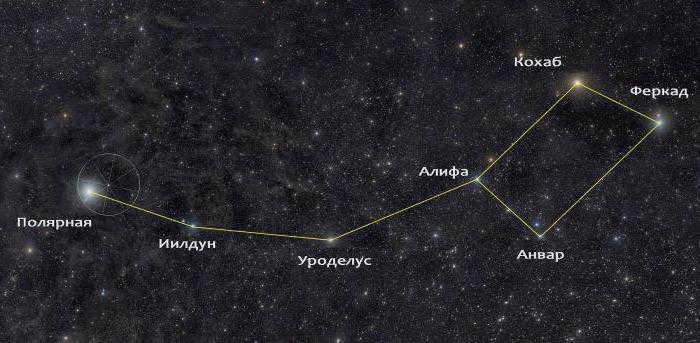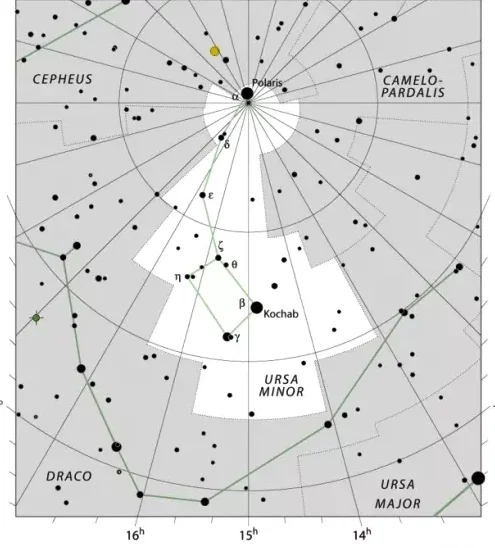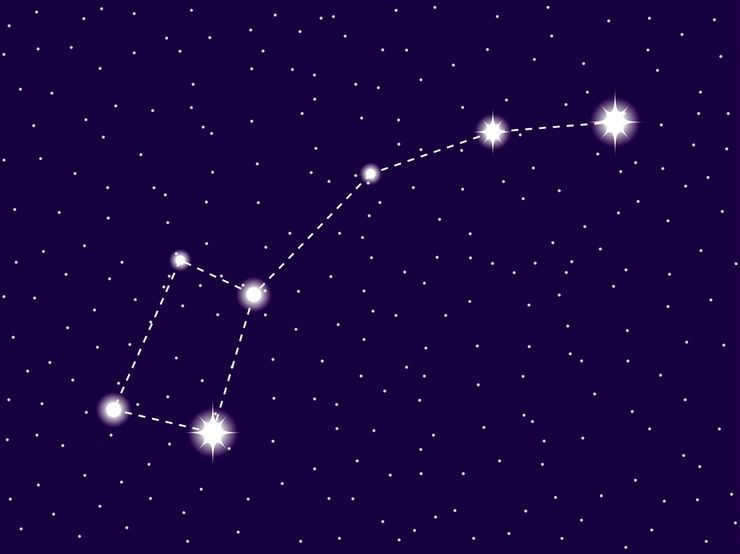
The Ursa Minor is a well-known constellation that is easily recognizable, despite its unassuming appearance. One of the reasons for its popularity is the presence of Polaris, the North Star, which has long served as a guiding light for travelers.
Location and Description
The Ursa Minor is located in the circumpolar region, making it visible all year round in the northern hemisphere. It is also known as the Little Bear or UMi. Its stars form a pattern resembling a dipper, similar to the Big Dipper, but with a distinctively curved handle.
In the celestial sphere, the constellation Ursa Minor can be found in the northern hemisphere. Polaris, also known as the North Star, is located at the end of the Little Bear’s tail and remains fixed in position. Its elevation above the horizon, measured in degrees, corresponds to the latitude of the observer’s location. Consequently, Polaris not only serves as a reliable compass pointing towards the north, but also provides a precise means of determining one’s coordinates.
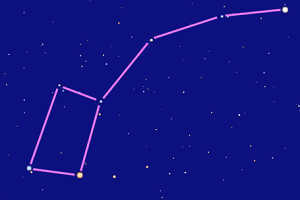
When it comes to size, the Little Bear is ranked as the 56th largest constellation among all. It covers an area of only 256 square degrees in the sky. Based on the latest data, Polaris, the main star of the Little Bear, is approximately 434 light-years away or 133 parsecs.
There are only three constellations that directly border the Little Bear, namely the Dragon, Giraffe, and Cepheus. As the northernmost constellation, it never sets below the horizon not only in Russia but also in all countries located north of the Tropic of Cancer.
The Little Bear constellation has been familiar to humans since ancient times. It was initially recorded in 600 BC. Even the Phoenicians utilized it as a navigational reference while at sea. According to mythology, the ancient Greeks became aware of the Little Bear when Thales of Miletus included it in the star atlas “Almagest”, compiled by Claudius Ptolemy in 140.
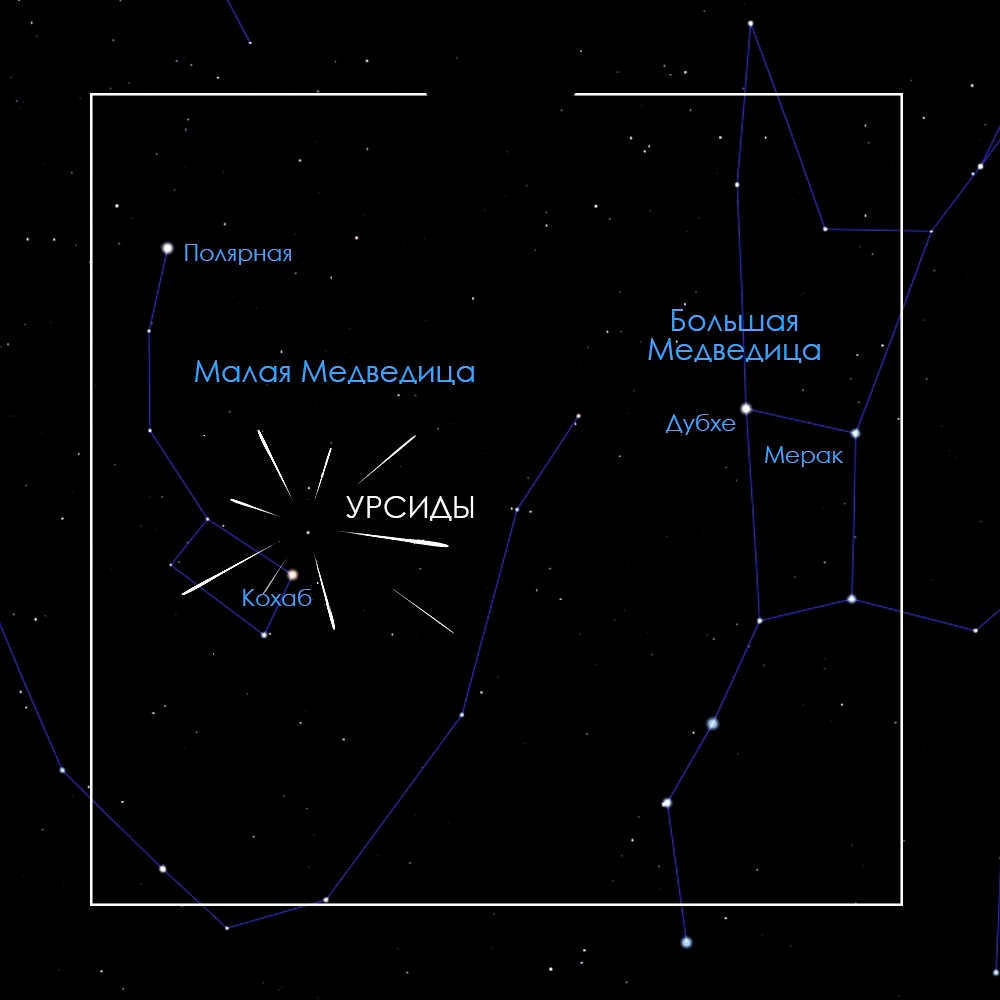
There are numerous myths surrounding this constellation, all of which vary. One of these legends is associated with the birth of Zeus, the primary deity of Ancient Greece. Zeus’ father was Cronus, a god who had a tendency to devour his offspring – it had been prophesied that one of his children would overthrow him and take his place.
Upon giving birth to Zeus, his mother Rhea took him to a sacred cave atop Mount Ida. It was there that the nymphs Melissa and Kinosura were entrusted with his care. Kinosura became Zeus’ nursemaid. Once Zeus grew into a mighty god, he elevated Melissa to the stars as the constellation Ursa Major, and Kinosura as the constellation Ursa Minor.
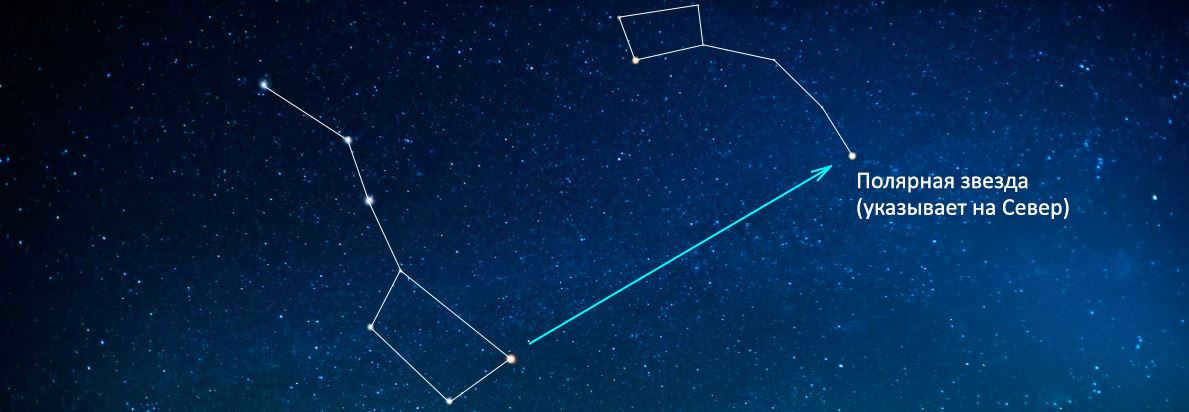

There are various versions of this legend as well. For instance, one version states that Zeus was nourished by the goat Amalthea and two actual bears, which later transformed into constellations.
Every culture has its own unique tale about the Big and Little Bears. The former is highly visible in the night sky, while the latter has the remarkable characteristic of orbiting around Polaris. Interestingly, the Kazakhs believed that this star was a nail, and the constellation itself was a harness fastened to it, worn around the neck of the Horse (also known as the Big Dipper). In India, the Little Dipper was seen as a monkey hanging from its tail, hooked onto the world pole.
Composition of stars
Polaris is the alpha of the Little Bear
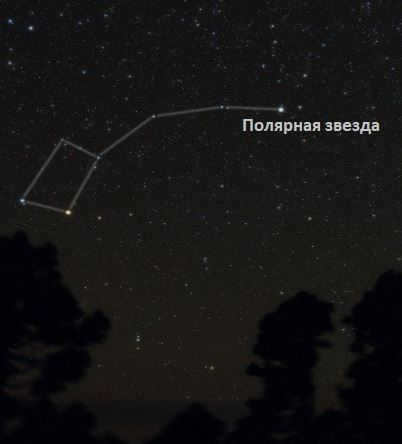

We are all accustomed to referring to Polaris, a member of the Little Bear constellation, as a star, although it is technically a star system. Not satisfied with being just a “Polaris” or an anomalous cepheid.
Polaris is also a triple star, meaning it has two companion stars that are gravitationally bound to it.
One of these companions is visible even in small amateur telescopes. It is a faint star of nearly 9th magnitude, located about 18 arcseconds away from Polaris. It was first observed in 1780 by the renowned 18th-century astronomer William Herschel.
Polaris is renowned for its massive size, measuring 4.5 times the mass of the Sun, and it belongs to the F7 spectral class, which categorizes it as a supergiant (Ib). Its diameter is a staggering 23 times that of the Sun, and its luminosity is an impressive 2500 times greater! Even Sirius appears dim in comparison to Polaris.
This star exhibits pulsating variable characteristics, with a period of 3.97 days. Scientists suspected its variability as early as 1852, and later, in 1911, Einar Herzsprung confirmed this fluctuation.


Polaris possesses a number of unique characteristics:
- There is a possibility that Polaris, along with its surrounding bright objects, represents the remains of a scattered-type cluster;
- Throughout its scientific recognition, Polaris has experienced a 15% increase in brightness;
- The pulsations of Polaris demonstrate a consistent decay, which has persisted for several decades;
- In the year 1900, the brightness of Polaris changed by 8%, whereas in 2005 it changed by 2%.
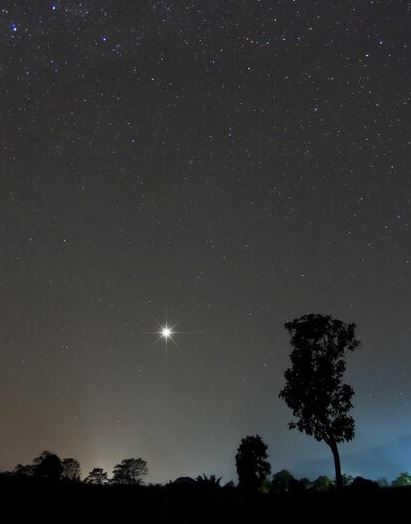

Before 1963, the brightness of Polaris used to change by more than 0.1 star magnitude, but then it gradually decreased. After 1966, it started decreasing rapidly and reached a level of less than 0.05 star magnitude. Since then, its brightness has been changing unpredictably within this range. According to measurements, the period of change in luminosity is approximately 3.97 days and it is currently increasing.
The period of change had been increasing steadily at a rate of 4 seconds per year until 1963. It remained constant for three years and then started increasing again in 1966.
Recent measurements indicate a consistent increase of 3.2 seconds per year. Research suggests that Polaris is now 2.5 times brighter in the sky compared to when it was observed by Ptolemy.
In January 2006, NASA released images taken by the Hubble telescope that revealed all the members of the triple system. The smallest companion, which is located 2.8 billion kilometers (18.5 astronomical units) away from Polaris, was not visible to us until then.
Cohab – β
Beta of the Ursa Minor is a massive star classified as K4 III. With a visual magnitude of 2.08, it is located approximately 130.9 light-years away from our solar system. This star is the most luminous one in the Ursa Minor constellation.
Kohab is 130 times brighter than the Sun and has a mass 2.2 times that of our star. Its name is derived from the Arabic word al-kawkab, meaning “star,” and is a shortened form of al-kawkab al-šamāliyy, which translates to “North Star.”

Yildun – δ
Yildun, also known as Delta of the Little Bear, is a white main-sequence dwarf star with a spectral type of A1V. It is situated approximately 183 light-years away from our planet Earth. Yildun has a visual magnitude of 4.35. The star got its traditional name from the Turkish word for “star”, which is yıldız. It is worth noting that the name Yildun can also be spelled as Vildiur, Jildun, Yilduz, or Gildun.
Ferkad – γ
Rephrase the text, making it unique, using the English language and preserving the HTML markup:
Ferkad – γ
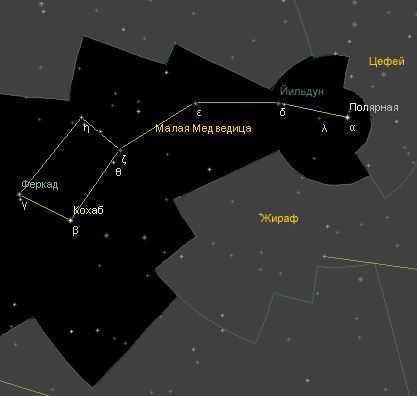

Gamma of the Little Bear is classified as an A-type star and has an apparent magnitude of 3.05. It is located approximately 487 light years away from Earth.
With a stellar classification of A3 lab, the Little Bear is considered an intermediate supergiant. It is known for its rapid rotation, with an estimated rotational velocity of 180 km/s. The star has a radius 15 times that of the Sun and is 1,100 times brighter.
The star’s traditional name, Ferqad, originates from the Arabic word “farqad” which means “calf”. This name is derived from the phrase “afafa al farkadayn” which translates to “dim one of the two calves”.
Alifa Al Farqadin – ζ
Zeta of the Little Dipper is a main-sequence dwarf classified as an A3Vn star. It is currently in the process of evolving into a giant star, with a mass 3.4 times that of the Sun and a luminosity 200 times greater.
The surface temperature of this star is approximately 8,300 degrees Celsius. Alifa Al Farqadin has a visual magnitude of 4.32 and is located 380 light-years away from Earth. The star’s name, afafa al-farqadayn, originates from the Arabic language.
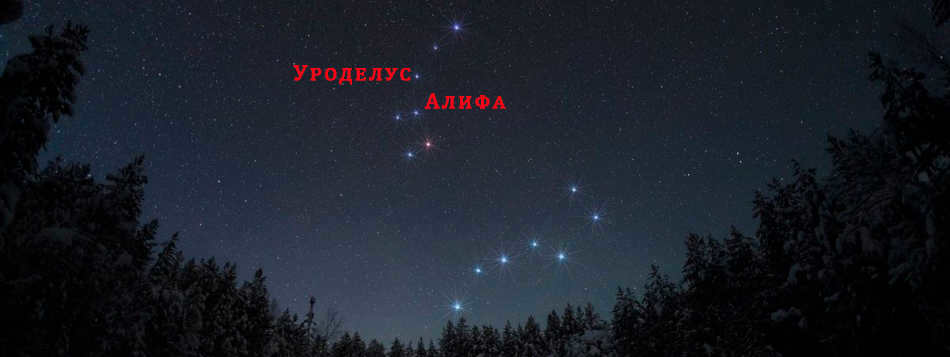
Urodelus – ε
Epsilon of the Little Bear is a binary star. The system consists of an orange giant at its center, which is 19 times larger and three times more massive than the Sun. It emits 225 times more light than the Sun, despite having a similar temperature due to its significantly larger surface area.
The second star in the binary system is a white main-sequence star that completes an orbit around the primary star in just 39.5 days. This indicates that the two stars are in close proximity to each other.
The brightness of the system fluctuates due to the periodic obstruction of the larger star by the smaller one, which is why Urodelus is categorized as an Algol-type variable star. Urodelus is located approximately 300 light-years away and is progressively approaching us at a rate of 10.5 km per second, resulting in a reduction in its distance.
Allaso – η
Allaso is the Greek letter “η”.
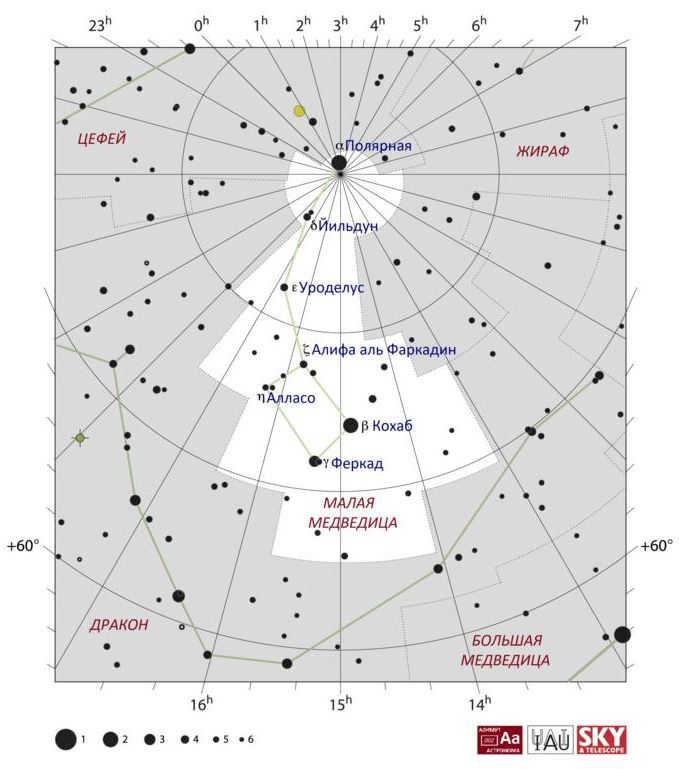
This constellation, known as Little Bear, also goes by the name Anwar al Farkadin. In the night sky, it appears as an ordinary star with a brightness of 4.95m. It is located at a distance of 96 light years from Earth.
Allaso is a binary star system. The primary star in this system is a white-yellow dwarf, which is nearly twice the size of the Sun and 1.66 times more massive. It is also slightly hotter. This is what we observe in the sky.
The second component of this system is not well understood. It is a red dwarf located 13 light years away from the primary star. Although this is a considerable distance, gravitational interactions can still occur at such distances.
Astrological Entities
The constellation of Ursa Minor is devoid of significant emission nebulae or deep cosmic debris due to its position outside of the Milky Way galaxy.
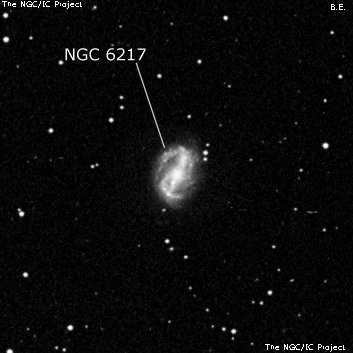
However, there are some remarkable objects that merit attention:
- NGC 6217 Galaxy. Situated 80 million light years away from Earth, this galaxy belongs to the category of barred spirals, where the arms of the galaxy do not emerge from the core, but from an elongated junction. The spirals of the galaxy are luminous and expansive, suggesting that they are currently undergoing rapid star formation processes. Observers can view the galaxy using telescopes and binoculars with an aperture larger than 80 mm.
Methods for locating constellations in the sky
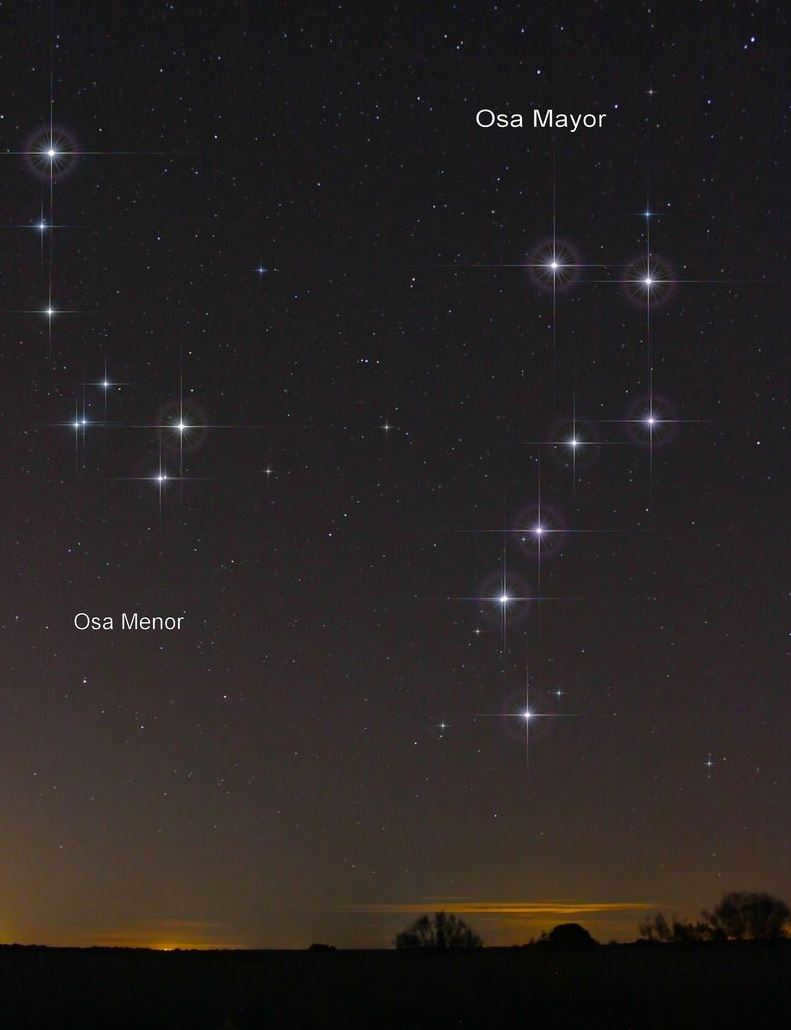

The constellation can be seen at latitudes ranging from -10 to +90 degrees. Unlike the larger and brighter Big Dipper constellation, the Little Dipper can be quite challenging to locate even under favorable observing conditions.
The best method to observe it is to visit a location with minimal light pollution on a clear night and search for the Big Dipper in the nighttime sky.
Similar to the Big Dipper, the Little Dipper consists of 7 stars. However, the brightness of the stars in the Small Bucket varies significantly. Only three of its brightest stars, α, β, and γ, can be seen in the illuminated city sky.
Polaris, also known as the alpha star of the Little Dipper, can be found at the tip of the handle of the Little Dipper. The stars Cohab and Ferkad make up the front wall of the dipper.
In order to view this constellation, it is important to choose a night with clear skies, as even slight cloud cover can obstruct the view of the constellation’s individual objects. Another important factor to consider is the phase of the Moon, specifically a waning Moon. Otherwise, the brightness of the Moon will make it difficult to see the Little Bear constellation. It is also recommended to find a location with minimal obstructions such as trees, buildings, poles, and towers for optimal observation.
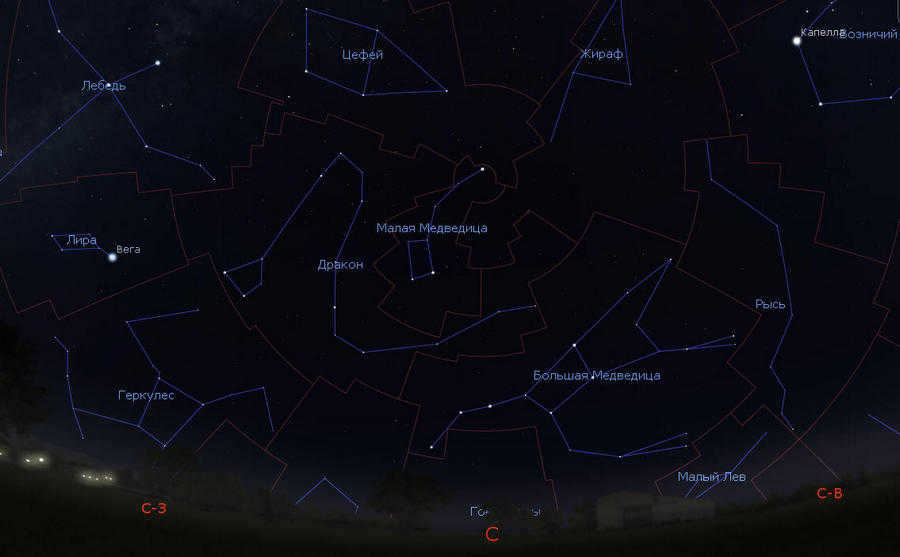
Spring or summer is the optimal time to gaze at the night sky. The position of the Ursa Minor constellation slightly changes depending on the season. This group of stars reaches its highest point in the sky from late March to the end of September. Therefore, it is most favorable to observe it during the warmer months.
The Earth’s movement significantly affects the placement of stars in the sky. As the Earth rotates on its axis, your geographic location in relation to the Big Dipper, as well as its elevation above the horizon, will vary depending on the time of year.
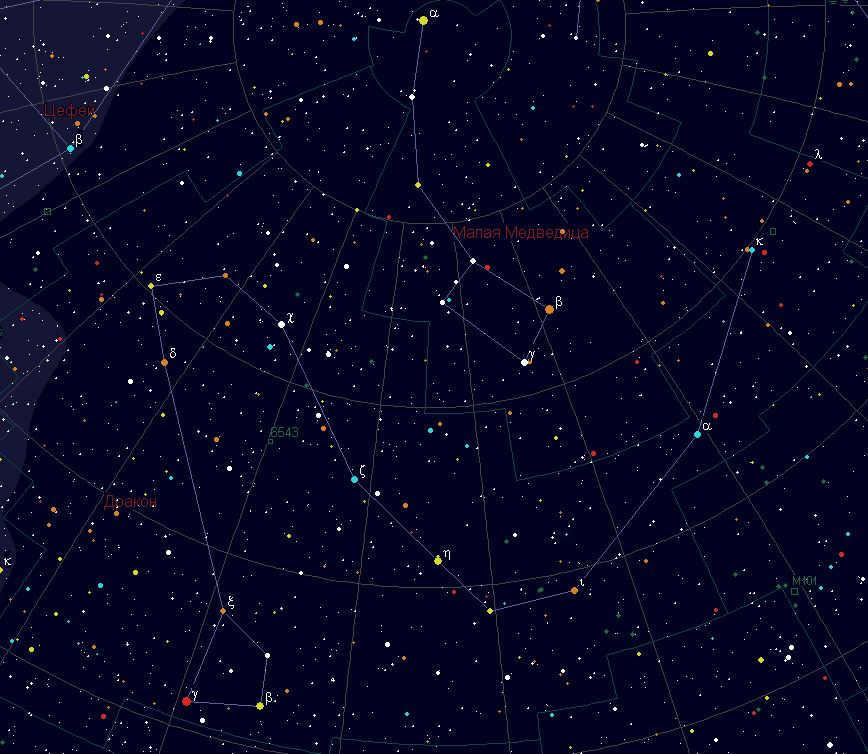
Although the Little Bear can be observed in the Northern Hemisphere throughout the year, it becomes more challenging to spot during the autumn and winter seasons as the constellation descends towards the horizon line.
During the winter months, the Little Bear “tilts” and its dipper points downwards towards the northeastern side of the horizon. The Big Dipper can be seen to the right and at a higher position during this time. Cassiopeia, located above the Little Bear, is clearly visible to the left.
At midnight during the summer, the Little Dipper takes its place above its older sibling. To the right, the inseparable duo is easily visible: Cassiopeia above and Perseus slightly below. To the left, positioned at a considerable distance, are the Magpie and the Northern Crown.
Asterisms
The constellation contains various asterisms, with the Little Dipper being the main one. It is a twin of its larger counterpart in the Big Dipper, sharing a similar shape and appearing close in the sky. The only distinction between the two is the slightly more curved handle of the Bear’s bucket.
Other asterisms found within the constellation include:
- Ring of Diamonds – Also referred to as the Engagement Ring, this asterism consists of several stars with a magnitude of 9-10. They form a ring, with the bright Polaris serving as the central diamond. To observe this asterism, it is recommended to use binoculars with an aperture of 50 mm or greater.
- Little Hanger. It is a scaled-down version of the well-known Hanger asterism found in the Foxy constellation. The Little Hanger measures a mere 20 angular minutes in size, and its component stars range from 9 to 11 in terms of star magnitudes.
Q&A
The Little Bear asterism is often mistaken for the Pleiades diffuse star cluster (M45) – it bears a resemblance to a miniature dipper. This star cluster is well-known across various civilizations, as it can be easily seen during winter in the northern hemisphere and summer in the southern hemisphere. Even individuals without any connection to astronomy can recognize this asterism – it is featured on the logo of Japanese car manufacturer Subaru (which is the Japanese name for the Pleiades). This cluster consists of young stars that are physically linked together and is situated in the Taurus constellation, approximately 350 light-years away. It can be easily observed with the naked eye. The Pleiades spans about 12 light-years in diameter and contains approximately 3000 stars, predominantly composed of hot blue stars. Scientists estimate the age of the Pleiades to be between 75 and 150 million years.
Video advice: locating Polaris and the Little Dipper
As you are aware, the prominent star pattern known as the Big Dipper holds great significance in the night sky of the Earth’s northern hemisphere. This constellation, often referred to simply as the Big Dipper, is accompanied by another constellation known as the Small Dipper, which is part of the Little Dipper constellation. (Did you know that the Little Dipper includes Polaris?) It would be beneficial to have knowledge of the Small Dipper’s position in the sky, as it is located near the celestial pole and can act as a valuable reference point. Let’s explore how to locate the Little Dipper in the night sky and how this information can assist us in navigation.
What is the appearance of the constellation of the Little Bear?
In order to understand how to locate the Little Bear in the night sky, it is important to have a visual understanding of what this small constellation looks like. Unlike the Big Dipper, which is much larger in size, the Little Dipper is primarily composed of the Little Ladle. One could argue that the Little Dipper is essentially the constellation of the Little Bear. (There are a few additional faint stars surrounding and within the ladle, but they are of little significance to us.)
Therefore, our search for this constellation in the sky will be focused on locating the Small Ladle. This is its appearance:
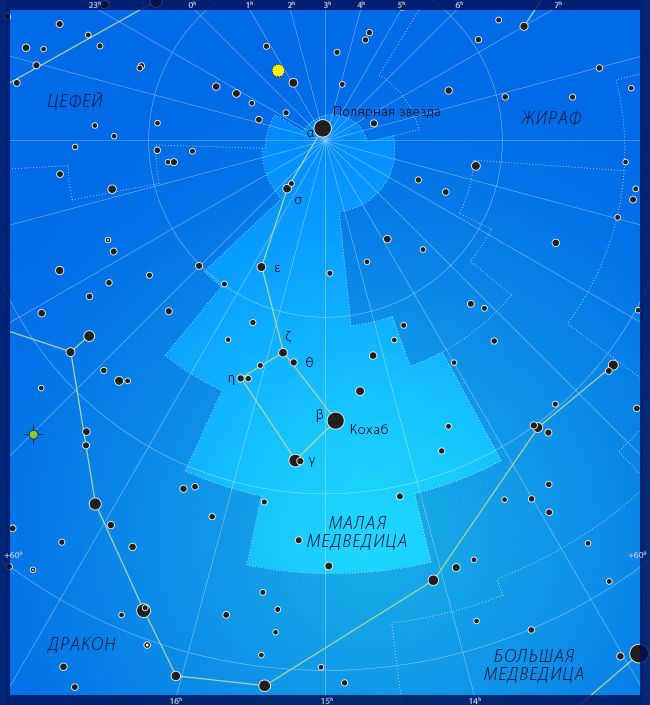
The constellation known as the Little Dipper can be seen on a map. Image: IAU/Big Universe
In contrast to the regular and stunning Big Ladle, the design of the Little Dipper is somewhat mismatched, isn’t it? The quadrangle of the bucket appears more like a box, and its handle has an oddly upward curve. It’s amusing to think that ancient Greeks, who created the constellation, saw it not as a handle, but as a long, non-existent tail of a bear. It’s almost comical: a bear with a tail that resembles that of a mongrel!
Please note: The Little Bear is not nearly as bright as the Big Dipper constellation. In fact, it only has three stars that are relatively bright. Therefore, locating it in the sky requires some experience and a bit of patience.
Having a general understanding of our objective, we can initiate our quest.
The most convenient approach to locate the Little Dipper is by utilizing Polaris (also known as α of the Little Dipper), the primary star of this constellation. Where can Polaris be found? To observe it, you must first locate the Big Dipper.
During the autumn and winter, the Big Dipper can be seen in the northern region, just above the horizon. In the spring evenings, it becomes visible in the eastern part of the sky, standing upright with the handle pointing downwards. In the summer, it is visible in the western sky with the handle pointing upwards. For additional details, refer to the article on How to locate the Big Dipper in the celestial sphere.
By mentally connecting the outermost stars in the Big Dipper, α and β, with a long, slightly curved line extending from the bottom to the opening of the dipper and beyond, you can locate Polaris. Polaris is approximately five times the distance between the α and β stars of the Big Dipper. It possesses a similar brightness to these stars. It is crucial to note that Polaris is not the most luminous star in the celestial sphere!
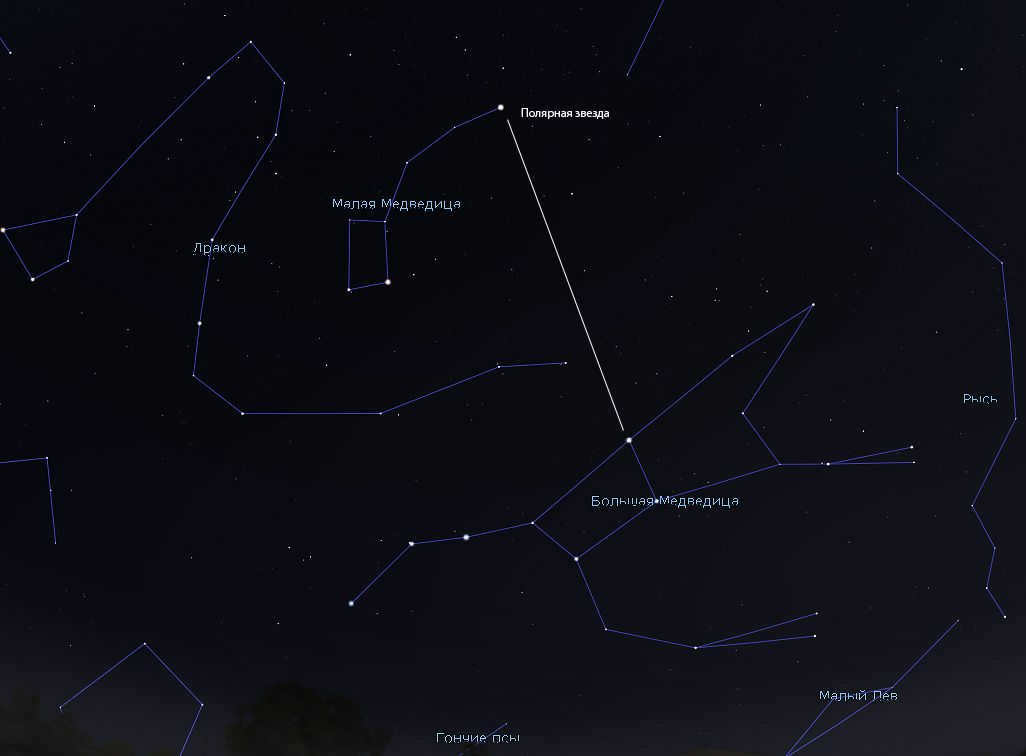
Locating the Little Dipper in the night sky is made easy by starting from its brightest star, Polaris. To find Polaris, you can follow the line that connects the outermost stars of the Big Dipper, Dubhe and Merak (as shown in the image). This line will lead you directly to Polaris.
Polaris is located at the end of the handle of the Little Dipper, while the bucket of the Little Dipper extends from Polaris towards the bucket of the Big Dipper. It is important to note that unlike the Big Dipper, the handle of the Little Dipper curves in the opposite direction.
The Small Bucket, similar to the Big Dipper, consists of 7 stars. However, the stars within the Small Bucket differ significantly in brightness. Only its three most luminous stars, α, β, and γ, are visible in an illuminated urban sky. Polaris, also known as α of the Little Dipper, is located at the end of the handle of the Little Dipper, while the stars of Kohab (β of the Little Dipper) and Fercadus (γ of the Little Dipper) make up the front wall of the bucket.
The Little Bear in the heavens
The remaining four stars of the Minor Pail are not always discernible in the city sky due to their faintness. This is likely the reason why novice stargazers frequently misidentify the Minor Ursa, mistakenly identifying even the minuscule dipper of the Pleiades as it.
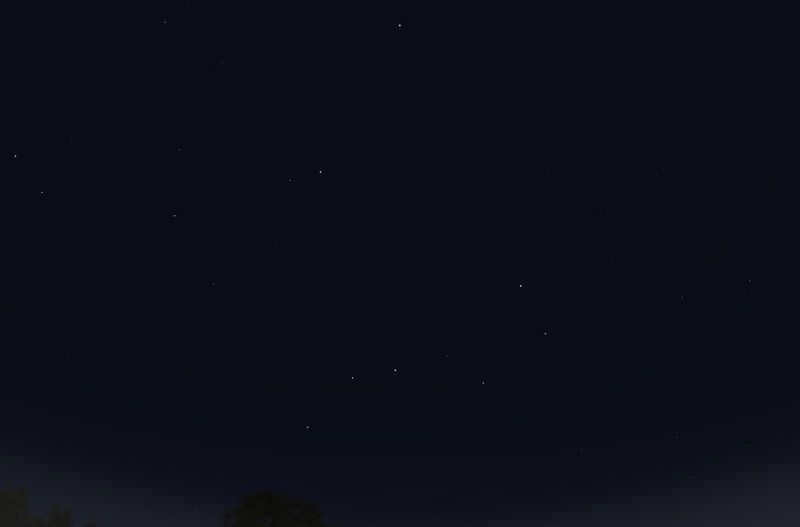
Identifying the Little Dipper can be challenging when surrounded by city lights. Within the red sky, four out of the seven stars that make up the Little Dipper are not visible. This leaves only Polaris (located above) and the Guardians of the Pole, which are the stars Cohab and Thercade. Figure: Stellarium
However, once you have spotted the Lesser Bucket at least once, it is unlikely that you will ever lose sight of it again. Why is that? The answer is quite simple: this constellation can always be found in roughly the same part of the sky, regardless of the time of year or day. Unlike many other constellations, it does not rise or set below the horizon, nor does it move in circles like the Big Dipper.
The Little Dipper functions as a colossal heavenly arrow connected to the immobile Polaris in the sky. This celestial appendage undergoes rotation, completing a full revolution within a precise 24-hour period. (This characteristic distinguishes it from a conventional clock hand, which completes a circle in a span of 12 hours.) Consequently, the stars comprising the Little Dipper possess the potential to serve as a timekeeping mechanism. Naturally, this capability can only be harnessed by those who possess the requisite knowledge.
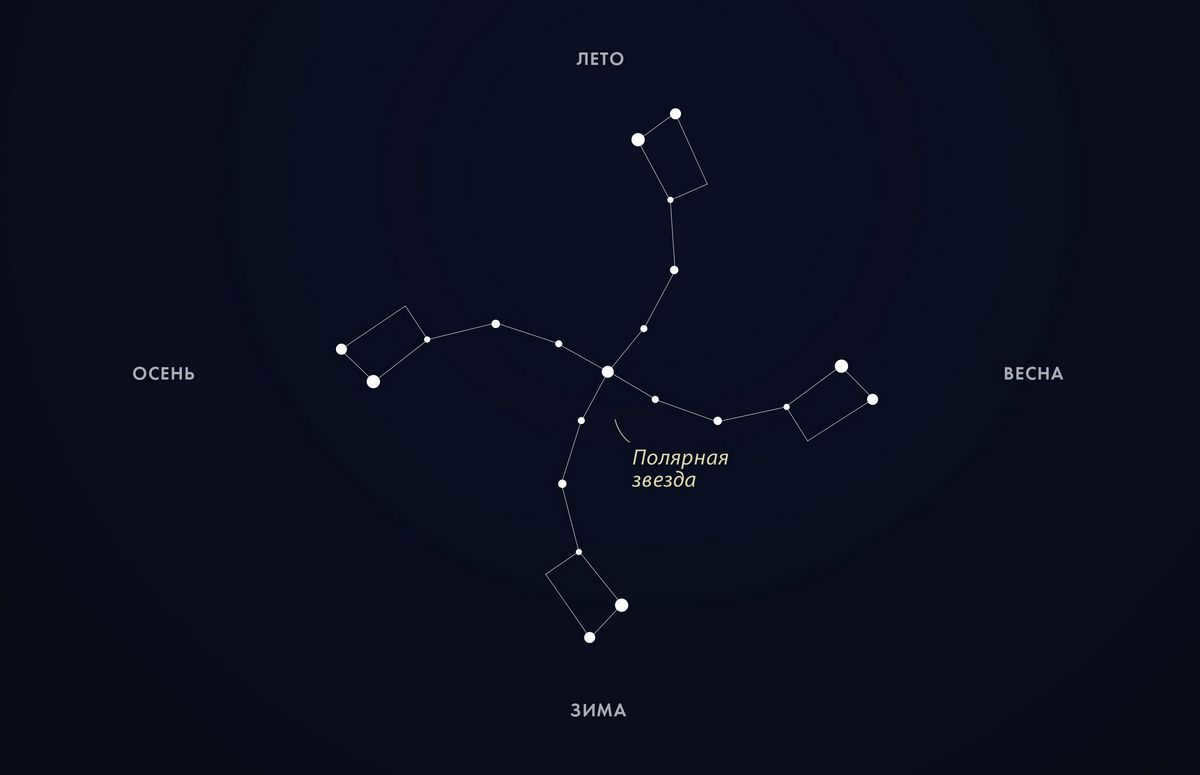
The evening position of the Little Dipper in the sky varies depending on the time of year. Illustration: The Vast Cosmos
Considering that Polaris aids in locating cardinal directions, the Little Dipper proves to be an incredibly valuable constellation!
The Little Dipper is the most renowned constellation among enthusiasts of the nocturnal sky. The cosmos is brimming with unexpected wonders and discoveries. There is an abundance to explore!
The celestial bodies that become visible in the sky turn out to be an immense amalgamation of gases, and the arrangement of constellations takes on peculiar shapes. Are there any similarities or are they all distinct?
Observing the night sky and gaining knowledge about the mysteries of the world can be a fascinating experience for both children and their parents.
Appearance of the Little Bear constellation
The Little Bear constellation, also known as the Little Dipper, is situated in close proximity to the Big Dipper and forms a miniature dipper shape. By connecting all the stars within it, one can easily recognize the familiar childhood vessel.
The cluster of celestial bodies comprising this constellation is relatively faint, making it easier to locate in a dark sky.
In order to spot this constellation with the naked eye, one must first locate Polaris, which stands out due to its size and brightness.
Human eyes perceive the brightest celestial body in the sky, but in reality, there are numerous objects that shine even more brilliantly. Nevertheless, Polaris outshines the rest with its remarkable radiance. This supergiant star is accompanied by two companions.
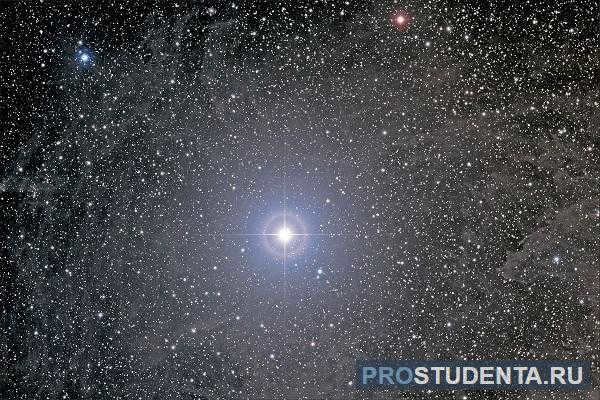
The central star is the main star, and it shines 2000 times brighter than the Sun. The discovery of the second companion was recently made due to its small size. The dwarf satellite remained unseen by telescopes on Earth for many years.
The names of the stars in the constellation Ursa Minor
The Ursa Minor constellation is composed of multiple components. While they may not shine as brightly as their counterparts in the Big Dipper, they are still clearly visible in a cloudless sky.
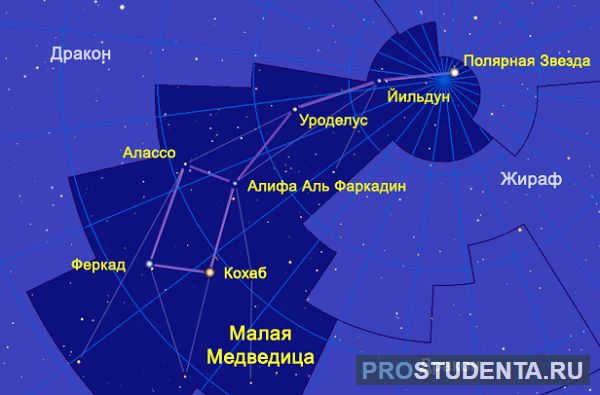
Four of the stars in the constellation have been given specific names, while the others are identified using letters from the Greek alphabet:
- Alpha, also known as Polaris, is the first star in the constellation and is the brightest star in the night sky.
- Beta, also called Cohab, is the second brightest star in the cluster and is an orange giant with a companion.
- Gamma is referred to as Fercadus. The names Beta and Gamma together mean “two calves” in Arabic.
- Delta, Epsilon, Zita, and Ita do not have specific names.
All of these stars are located more than 400 light-years away from Earth.
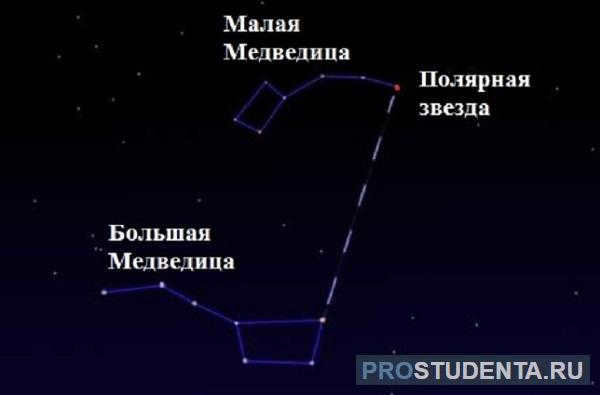
Here is a brief guide:
- Select a night with clear weather. In a sky without clouds, it is much simpler to locate the faint lights of Ursa Minor. It is preferable to choose a location without artificial lighting. Finding such a location in large cities can be challenging, so you may need to venture further to the outskirts.
- Locate the Great Dipper in the sky. It is difficult to mistake it for anything else, as the stars in this constellation shine brighter than others due to its relatively close proximity to Earth. It has a trapezoid shape with a long handle.
- Find the North Star, Polaris. It is located further north than the Big Dipper and serves as the endpoint of Ursa Minor.
- That is what you are searching for. Mentally trace a line from the handle of the Dipper to the Dipper itself, and the entire constellation will be visible before your eyes.
Locating Polaris in the sky
One simple method for finding Polaris is by using the Big Dipper. The Big Dipper is a prominent constellation that is visible year-round in Russia and other northern hemisphere countries. It is shaped like a large spoon or ladle.
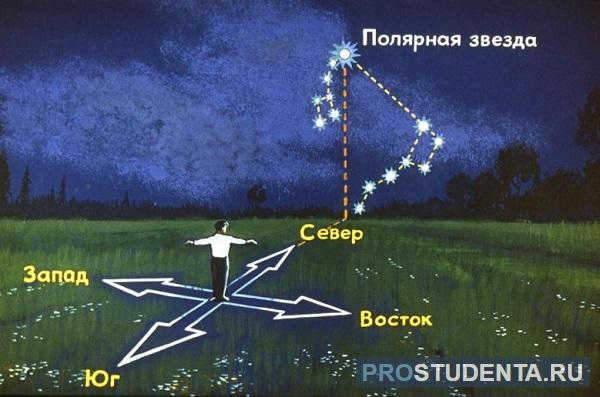
To locate the Lesser Bear, one must mentally extend a line five times the length of the segment connecting its outermost points.
An alternative method for locating a Cepheid is by employing a compass. Polaris served as a navigational aid for explorers, leading them towards the North Pole.
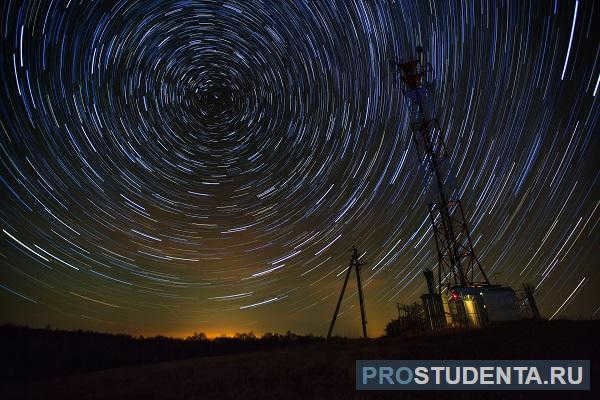
By carefully observing the celestial body, one can easily notice its unique characteristic of remaining stationary in the night sky. While other constellations gracefully traverse the heavens as the night unfolds, this particular luminary remains fixed in its position above the North Pole.
What is the reason behind naming the constellations after bears?
Despite the fact that the constellations bear no resemblance to actual bears, neither in color nor in shape, they were given the name “bears”. The origin of this name can be traced back to the Greeks, who were aware of their close proximity to the North Pole.
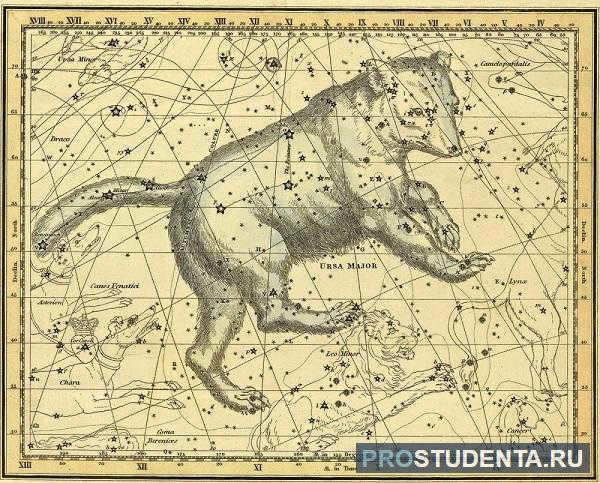
A map was considered a great luxury, so they relied on the sky for navigation. Surprisingly, their assumption from as early as 545 BC turned out to be accurate.
Who is the primary inhabitant of the North Pole? It’s the bear, of course. This is why there are two constellations near the northernmost point of the planet named after the bear.
Myths and legends surrounding the Big and Little Dipper
The existence of constellations has been known for centuries. Even in ancient times, they served as guides for travelers. However, for the ancient Greeks, these constellations were more than just bright dots in the sky.
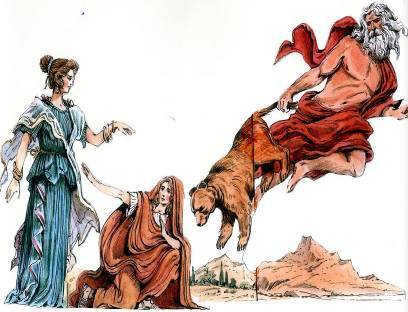
Legend has it that the mighty god Zeus once had a clandestine paramour. The tale goes that she possessed an ethereal beauty that captivated the attention of every man. Her name was Callisto.
One fateful day, the young woman made a misstep and paid a heavy price. She was transformed into a fearsome bear. Zeus, determined to safeguard her beauty, cast her into the heavens, but in his efforts, he inadvertently elongated her tail. Hence, the Big Dipper’s elongated tail.
The girl’s loyal companion was her dog, which was also transformed into a bear cub that ascended to the skies alongside her. This tale was widespread among the ancient Greeks.
The vastness of the night sky holds countless wonders waiting to be discovered. Even the familiar bears can teach us a multitude of fascinating facts. Who knows how many undiscovered constellations reside in the depths of space? Knowledge is the key that unlocks the door to the boundless universe that surrounds us.
When we reflect on the past, the constellation known as the Little Bear holds a significant place among the many celestial formations. Historical evidence suggests that ancient sailors relied on the stars within this constellation for navigation. Although the Phoenicians occasionally utilized the Big Dipper for guidance, its intense luminosity often led to considerable inaccuracies in determining their course.
Undoubtedly, most of you will easily locate the Great Bear. It is quite distinctive and luminous. Given that both constellations are in close proximity, it will undoubtedly become apparent how to locate the Little Bear next to the Great Bear. To accomplish this, mentally connect the last two stars of the Great Bear: from Merak (β of the Great Bear) to Dubhe (α of the Great Bear), extending this line upwards by a distance of 5 times the distance between them. This is how you will locate Alpha (Polaris) of the Little Bear constellation.
Before contemplating how to find the Little Bear constellation solely based on the position of Polaris, it is important to understand the pattern formed by the stars and how the asterism is situated in relation to the Great Bear.
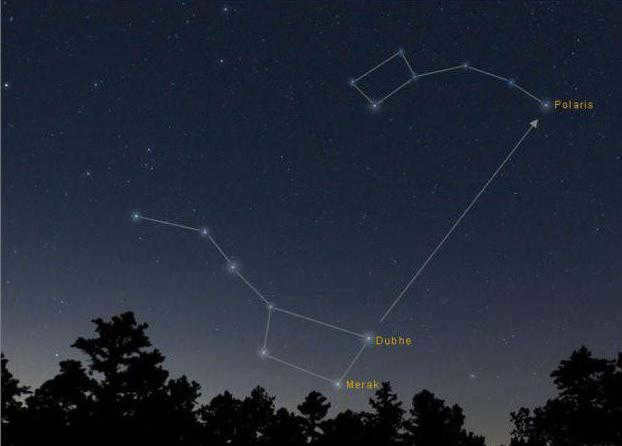
In order to gain a complete comprehension, it is important to note that the names of these constellations are quite similar and they bear a resemblance to the shape of a bucket. In terms of their position in the sky, the Little Dipper is essentially inverted in relation to the Big Dipper.
The Power of Knowledge
Prior to commencing your search, it is advisable to familiarize yourself with a star chart. This will facilitate the identification of the asterisk, making your quest much simpler. In due course, you will develop the ability to easily locate the desired star cluster. Additionally, armed with a comprehensive understanding of the subject matter, you will be able to provide clear instructions on how to find the Little Bear adjacent to the Big Dipper, if someone were to inquire.
Now equipped with the knowledge of how to locate the Little Bear constellation, let us delve into the topic of Polaris. This particular star played a crucial role for past travelers and navigators during lengthy and arduous journeys. Despite not being the most luminous star in the night sky, it is positioned closest to the northernmost point on Earth, with an error margin of only 1 degree. However, after a mere 145 years, this margin of error will exceed one degree.
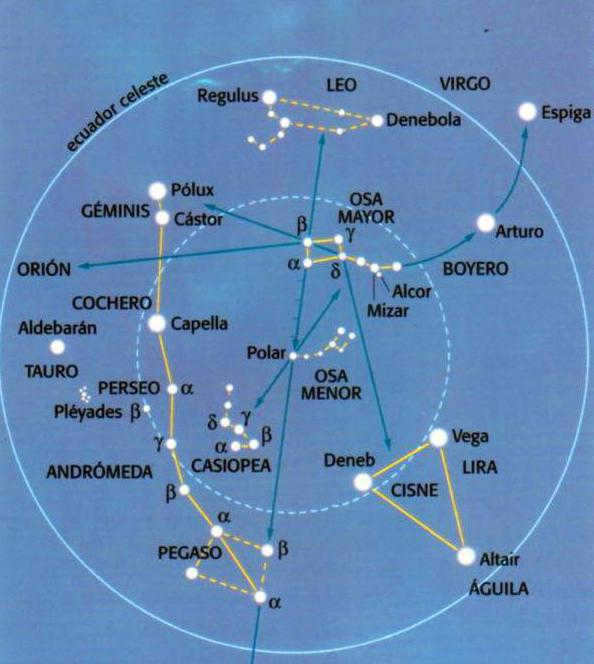
It is only after the year 3200 that Alderamin (alpha Cepheus) will become the closest star to the northern point of the world.
"Spinning" the bear by the tail around the Earth’s axis
Despite the Earth’s daily rotation on its own axis and its annual orbit around the Sun, Polaris remains stationary. The brightness of this guiding star fluctuates with a 4-day period, with an intensity range of 2.02 ± 2%. In the past, the amplitude of the luminosity was higher, but it has now stabilized. The total brightness of Polaris is continuously increasing and has risen by almost 15% over the past century.
The pulsation’s nature is connected to the luminosity characteristic, which is precisely how Cepheids exhibit their behavior. The guide star is among the most brilliant cepheids in the nocturnal expanse.
The Little Dipper encompasses approximately 255.9 square degrees in the celestial sphere. Its closest companions are the Dragon and Cepheus.
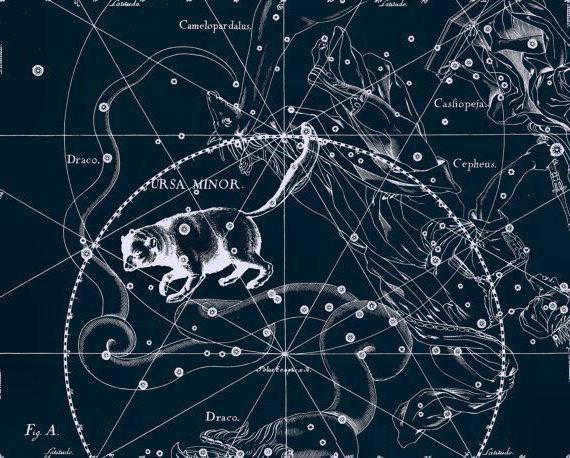
As previously stated, the asterisk represents the North Pole of the World, which is the point on the celestial sphere where all objects revolve around. The first recorded mention of this was by the Greek astrologer Ptolemy in the 2nd century.
The Ursa Minor and its celestial bodies
The Ursa Minor constellation consists of seven prominent objects. Out of all the stars in the Ursa Minor, only the three brightest ones are clearly visible. These stars are Ferhad and Kohab, which form the Ladle’s wall, and Polaris, which crowns the constellation’s handle. The last two stars are located above the end of the Big Dipper’s tail.
The Lesser Bucket stands out from other constellations due to its unique characteristics. Unlike the Big Dipper and other asterisms, which have a seasonal presence and shift position in the sky throughout the year, the Lesser Bucket remains stationary. While most constellations can only be observed during specific seasons, the Little Dipper, for instance, also undergoes changes in location as it revolves around its Alpha.
“Alpha and omega” constellations of the Little Bear in the northern hemisphere
The Little Bear constellation in the northern hemisphere is known for its Alpha star, also called Polaris. It is situated approximately 431 light-years away from Earth and has an apparent magnitude of 2.02. Recent discoveries have revealed that Polaris is not a single star, but rather a triple star system. The brightest star in this system shines with a brightness nearly 2,000 times that of the Sun. The second star in the Little Bear constellation has a mass equivalent to 1.39 times that of the Sun.

With the aid of a small telescope, one can observe the polar bear constellation. The third Alpha star is 1.25 times more massive than our Sun and is located in close proximity to the first star. By using the Hubble telescope, scientists were able to distinguish it as an individual star.
Kohab, also known as the Star of the North, is an orange-colored giant star. It is the second brightest star, referred to as beta, in the Lesser Dipper constellation, with a stellar magnitude of 2.8. Kohab is situated 126 light-years away from Earth.
Ferhad is the gamma star in the Little Dipper constellation, with a magnitude of 3.6 and a distance of 480 light years. This celestial object is classified as a hot giant with a temperature of 8600 K and belongs to the variable star category.
Zeta is a different small star, having a color that is white, and it can be found approximately 380 light years away from our planet Earth. The brightness of this star is 200 times greater in comparison to the brightness of our Sun. It is currently in the process of transforming into a massive star.
Polaris is always reliable
It might not be possible to remember all of this information, but at least your knowledge has expanded. And in case you ever find yourself lost in a forest without any cell phone signal, try to recall how to locate the Little Bear using the Big Dipper. You will definitely be able to find Polaris and determine the direction of north.
The secrets and mysteries of the sky are abundant and unknown
Even without the aid of a telescope, a simple gaze upwards at the celestial bodies during the night reveals the vastness and diversity of our expansive universe.
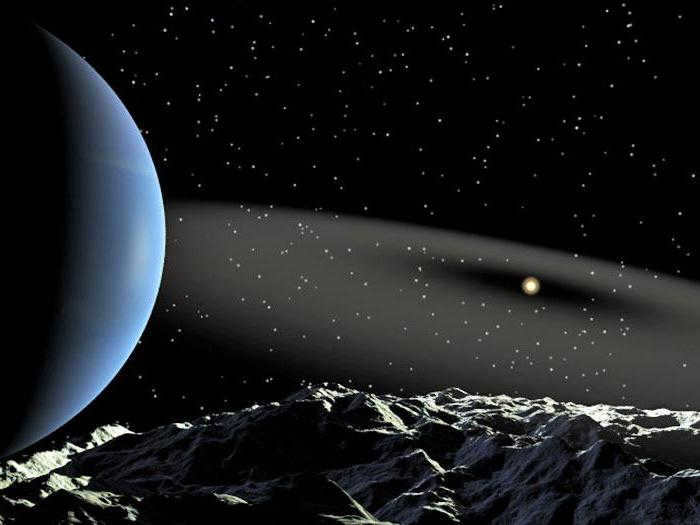
The Little Bear constellation represents only a small portion of what is visible to us. The Universe we observe has well-defined boundaries and a size that spans approximately 14 billion light years.
However, is this depiction of the Universe an accurate reflection of reality? This question provokes contemplation among esteemed scientists, who develop hypotheses, conduct investigations, engage in debates, and strive to comprehend the true nature of our existence. Some experts propose that the Universe is infinite, while others argue that a Multiverse exists.
There is a possibility that among those galaxies, there exists a planet, a nation, and an identical version of yourself. The realm of possibilities knows no bounds as science continues to uncover the mysteries and secrets that lie beyond our perception. It consistently proves that what appears fantastical in the present will inevitably become a reality in the future.
Among the celestial formations, the Little Bear constellation holds a significant place. Despite its diminutive size and lack of prominent stars, its location near the north pole has bestowed it with great importance in the realm of astronomy, navigation, and various other fields throughout centuries.
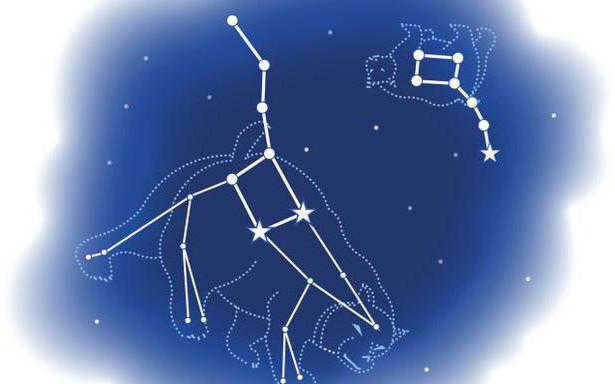
Constellation’s Origins
One of the oldest star clusters, the constellation’s exact origins are difficult to determine. Homer mentioned the Big Dipper in ancient texts, but information about the Little Dipper was recorded later, around the 7th century BC. Strabo wrote that it is likely the Little Bear did not exist in Homer’s time, as this group of stars was not yet known until the Phoenicians started using them for navigation.
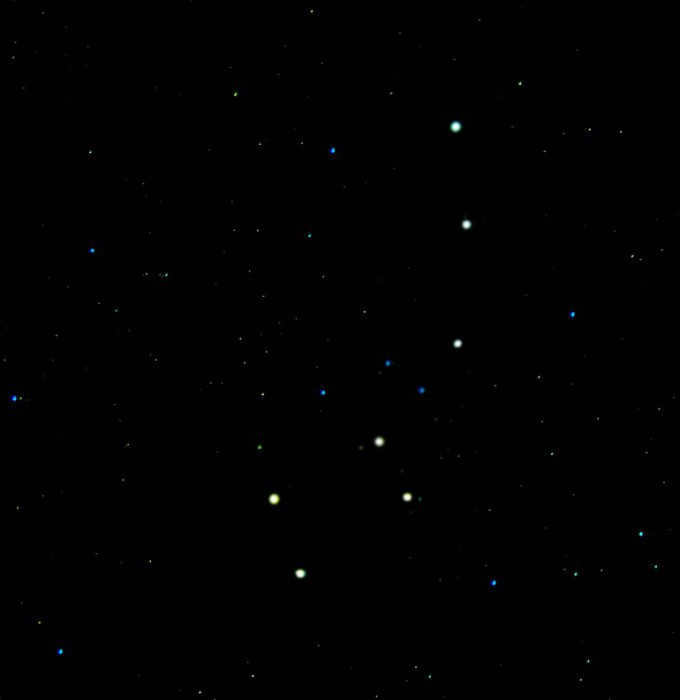
Myths and legends
There are various tales and legends surrounding the constellation. One popular myth recounts the story of how the birth mother Rhea cunningly protected her baby from his father Cronus, who had a habit of killing all his children due to a prophecy. To outsmart Cronus, Rhea cleverly replaced the infant Zeus with a stone. She then concealed the baby in a hidden cave, where he was nurtured by two bear-like women named Helis and Melissa. Eventually, these caretakers transported Zeus to the heavens. As Zeus grew older, he successfully overthrew his father and rescued his siblings, who subsequently ascended to become the revered Olympian gods.
There is another story that tells of Callisto, the daughter of Lycaon, the ruler of Arcadia. According to the legend, Callisto possessed a unique beauty that caught the attention of Zeus. In order to approach her, Zeus disguised himself as the goddess-hunter Artemis, whom Callisto served. Zeus and Callisto had a child together named Arkan. However, when Zeus’ wife Hera discovered the truth, she transformed Callisto into a bear. Years later, Arkan grew up and went out hunting. He came across the tracks of a bear and unknowingly followed them, intending to kill the beast. But Zeus intervened and turned his son into a bear as well. He then lifted Callisto and Arkan into the sky. Hera was infuriated by this act and sought the assistance of Poseidon, asking him to banish Zeus’ mistress and their child from his kingdom. As a result, the constellations Ursa Minor and Ursa Major, also known as the Little and Big Dipper, are forever prevented from crossing the horizon.
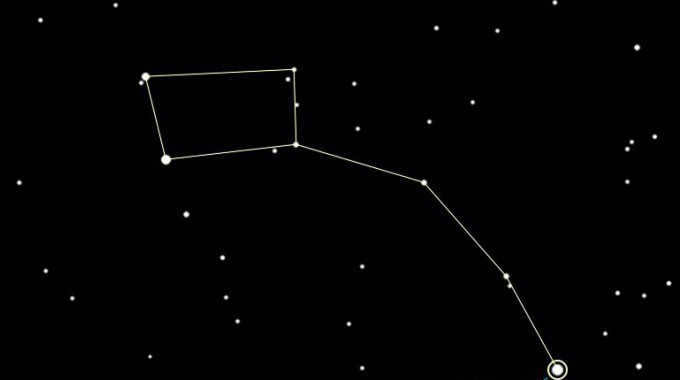
Locating the constellation
If you’re wondering where to find the Little Bear, and how to locate it, it’s important to have an idea of what it looks like. The primary feature of the constellation is the dipper, although it may not be as noticeable in the night sky as the dipper in the Big Dipper.
To locate all the stars in the constellation, the first step is to locate the Big Dipper. Start by drawing an imaginary vertical line with a slight curve that passes through the outermost stars of the dipper. Extend this line upward by five similar segments. This line will guide you to Polaris, a bright star that marks the end of the handle of the Little Dipper. What comes next? Where is the Little Bear and where do we go from Polaris? From Polaris, we need to move towards the Big Dipper, which is where the dipper itself is situated. Unlike the Big Dipper, the handle of the Little Dipper bends in the opposite direction. Now it becomes clear where the Little Bear is positioned in relation to the Big Dipper.
In this particular constellation, similar to the Big Dipper, there are seven stars, although they are not as prominent. The three stars stand out the most, while the remaining four may not always be easily discernible in the dark sky. This unique characteristic often leads amateur astronomers to mistakenly identify the Pleiades as the Little Dipper. However, once you have located the Little Dipper and become familiar with its position, it is highly unlikely that you will ever lose sight of it again.
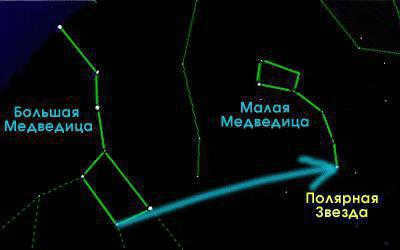
The most luminous stars of the dipper
In order to determine the location of the Little Bear, it is necessary to acquire the skill of identifying Polaris. The procedure of finding it is described above.
The Little Dipper is formed by the following stars:
There are additional stars that constitute the dipper and the handle.
Polaris will indicate the location of the constellation of the Little Dipper. It is the brightest star, comparable in brightness to the objects of the Big Dipper. Interestingly, it only ranks 48th in the list of the brightest stars, and contrary to popular belief, it is not the brightest. Polaris can be likened to a nail that remains fixed in the night sky, around which all other stars revolve.
The next celestial body in the night sky is Cohab or Beta. It possesses a brilliance similar to that of Polaris. Cohab emits a warm orange glow. This particular star has a lower temperature compared to our sun and is a whopping forty times larger in size.
Ferkab, on the other hand, is another massive star. It is hotter than both Cohab and Polaris, but its brightness is several times less.
All the celestial bodies in the constellation
Ferkab, Cohab, and Polaris are the most prominent stars in the Little Bear constellation, always visible to the naked eye. Within the constellation, there are a total of forty-seven objects, but only seven can be observed without any aid, and even then, only under favorable weather conditions. Typically, only three stars are visible.
